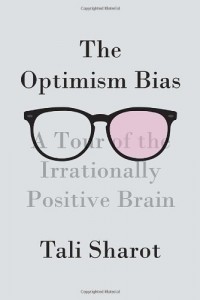
The more drunk you are, the slower you drive, and the game ends with a crash, and a prompt to take a taxi home instead. They decided to place these urinals in bathrooms, and designed them such that each urinal controls the car.
#TALI SHAROT OPTIMISM BIAS DRIVERS#
The product developers teamed up with Frankfurt’s taxi services to produce a game that would help reduce drink-driving by persuading drunk drivers to take taxis home instead.

Germany’s “piss screens” are an interesting example of this suggestion - no kidding, they’re really called that.

Make negative events obvious Bringing negative events to our mind just before we’re likely to engage in an undesirable act can be a good behaviour change technique.Incorporating these two concepts into product design or marketing collateral can go a long way towards helping reduce the risks of this bias. There are two researched ways of reducing the Optimism Bias (Jolls & Sunstein, 2006): Highlight the Availability Heuristic (make past bad events more easily retrievable from one’s memory) and use Loss Aversion (highlight losses that are likely to occur because of these bad events). Hospitals, Nuclear power plants and oil refineries good examples. Use other biases to limit the effects This bias is particularly important for decision-makers creating health or safety products, where the dangers of being overly optimistic can lead to dreadful outcomes.Going further, were it not for the Optimism Bias, it’s suggested that we might otherwise all be mildly depressed! So how does is this bias relate to creating and marketing great products? Let’s find out… Key takeaways for Decision-Makers And while this can be dangerous, it can also be adaptive, helping us avoid mental health issues such as depression. This intriguing research suggests that our brains deliberately choose to ignore information that we don’t really want to hear, whilst embracing the good stuff. Essentially, people changed their beliefs selectively in light of only positive information, indicating that we’re biased towards believing only the positive.

a smaller chance of suffering from a disease than expected), they were more likely to reduce their new estimate to closely match it.Īnd I’m sure you can guess what the participants did with the more negative information… Those who received information worse than their original estimate tended not to change their estimations much. When asked afterwards to estimate a second time the chances of these bad events occurring, they found that people who received information more positive than their initial thoughts (i.e. They were then shown the average chance of actually suffering such events.

Sharot and co conducted a study asking people to guess how likely it was that they’d experience certain bad things (such as Alzheimer’s disease) in their lifetime. In one study, where people were asked to imagine experiences both desirable (A lottery win, an awesome date etc) and undesirable (ending a relationship or losing one’s wallet), their mental image of the positive events were more intense and rich than the negative ones.Īnd as well as spending less time mulling over negative outcomes than we do over positive ones, it’s been shown that optimists save more, are more healthy, take more vitamins and more readily adopt a low-fat diet.īut let’s not get carried away with all this good news, because the truth is that this bias is a little crazy…dangerous even. Over the years, Tali Sharot and her colleagues at University College London have found countless evidence of the Optimism Bias.


 0 kommentar(er)
0 kommentar(er)
